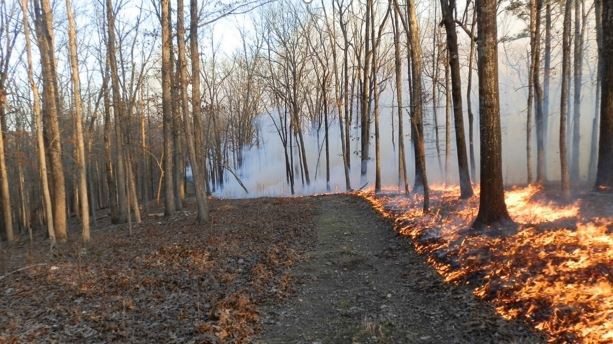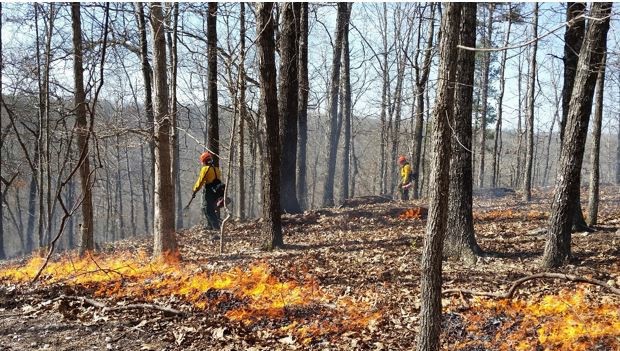AgEBB-MU CAFNR Extension
Green Horizons
Volume 22, Number 1
Winter 2018
Agroforestry
Winter Frost to Spring Fire
By Rebecca Landewe| The Nature Conservancy
With winter days growing longer, spring will be around the corner soon. This late-winter window is a time when many landowners are preparing for the new spring growth through the use of an increasingly popular management tool - prescribed fire, also
known as controlled burning.
Fire is an important component of natural community management in Missouri, as it was a regular part of the landscape before European settlement. Many plants and plant communities are dependent on fire to thrive. Open woodlands, which are characterized by widely spaced trees and an abundance of native grasses and wildflowers in the understory, require fire to maintain their character. These woodlands, as well as glades, prairies, and other grasslands benefit from the nutrient cycling and reduced leaf litter that a controlled burn can provide. Turkey, quail, and other grassland birds respond well to the food and habitat fostered by the use of fire.
Controlled burns also reduce the risk and severity of wildfires, improve pasture condition, and can be helpful for treating certain invasive species. Talking with a professional forester and wildlife biologist from the Missouri Department of Conservation (MDC) can help you determine if fire is a good tool for you.
Fire is not a panacea and also comes with some risk. The Natural Resources Conservation Service (NRCS) has a helpful guide that describes steps to conducting a successful controlled burn (https://efotg.sc.egov.usda.gov/references/public/MO/PrescribedBurn_InfoSheet_4_08.pdf).
Here are a few things to keep in mind:
Attend a training - MDC occasionally offers a class for landowners to learn more about prescribed fire. See Resources below for events and newsletter sign-up.
Prepare a burn plan - Work with a professional to have a burn plan prepared for your property. It is important to prepare a burn plan that outlines the best conditions for conducting the controlled burn. Humidity, temperature, and wind speed are all critical factors to consider and ensure your burn is safe and meets your management goals.
Prepare your fire lines (i.e., firebreaks) - Well- prepared fire lines are crucial for minimizing the potential for an escape.
Assemble your crew - Having a trained, qualified burn boss to supervise the burn is important (see NRCS guide). There are a few contractors available that can implement a controlled burn on your property. In some areas, neighbors are helping neighbors with controlled burning through local Prescribed Burn Associations. Talk with your local MDC representatives to see if there is one near you.
Wait for the weather conditions outlined in your burn plan - Be ready to cancel your plans if the conditions are not correct or unsafe.
Notify authorities - The day before or morning of the burn, notify neighbors, local fire departments and local authorities about your controlled burn.
 |
Prescribed burns require careful planning, photo copyright TNC (Tom Fielden) |
 |
Photo copyright TNC (Tom Fielden) |
